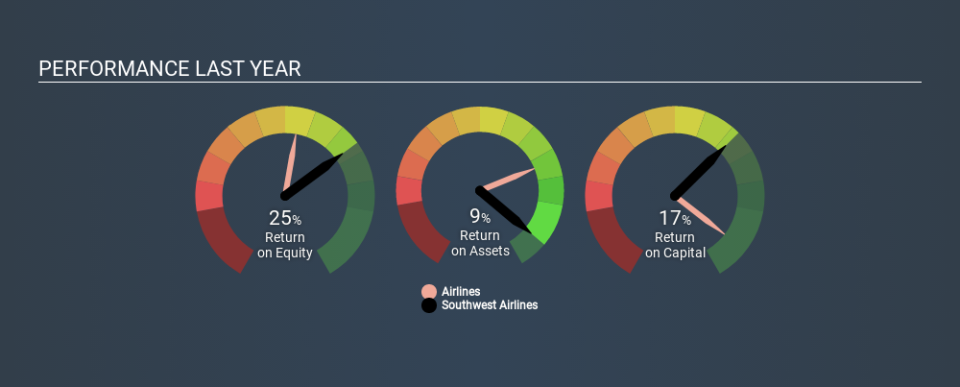Are Southwest Airlines Co.’s (NYSE:LUV) High Returns Really That Great?

Today we'll look at Southwest Airlines Co. (NYSE:LUV) and reflect on its potential as an investment. Specifically, we'll consider its Return On Capital Employed (ROCE), since that will give us an insight into how efficiently the business can generate profits from the capital it requires.
First of all, we'll work out how to calculate ROCE. Then we'll compare its ROCE to similar companies. Finally, we'll look at how its current liabilities affect its ROCE.
Understanding Return On Capital Employed (ROCE)
ROCE measures the amount of pre-tax profits a company can generate from the capital employed in its business. In general, businesses with a higher ROCE are usually better quality. Overall, it is a valuable metric that has its flaws. Renowned investment researcher Michael Mauboussin has suggested that a high ROCE can indicate that 'one dollar invested in the company generates value of more than one dollar'.
So, How Do We Calculate ROCE?
Analysts use this formula to calculate return on capital employed:
Return on Capital Employed = Earnings Before Interest and Tax (EBIT) ÷ (Total Assets - Current Liabilities)
Or for Southwest Airlines:
0.17 = US$3.1b ÷ (US$26b - US$8.6b) (Based on the trailing twelve months to September 2019.)
So, Southwest Airlines has an ROCE of 17%.
View our latest analysis for Southwest Airlines
Does Southwest Airlines Have A Good ROCE?
One way to assess ROCE is to compare similar companies. Using our data, we find that Southwest Airlines's ROCE is meaningfully better than the 11% average in the Airlines industry. We consider this a positive sign, because it suggests it uses capital more efficiently than similar companies. Regardless of where Southwest Airlines sits next to its industry, its ROCE in absolute terms appears satisfactory, and this company could be worth a closer look.
Southwest Airlines's current ROCE of 17% is lower than its ROCE in the past, which was 27%, 3 years ago. This makes us wonder if the business is facing new challenges. The image below shows how Southwest Airlines's ROCE compares to its industry, and you can click it to see more detail on its past growth.
Remember that this metric is backwards looking - it shows what has happened in the past, and does not accurately predict the future. ROCE can be misleading for companies in cyclical industries, with returns looking impressive during the boom times, but very weak during the busts. This is because ROCE only looks at one year, instead of considering returns across a whole cycle. What happens in the future is pretty important for investors, so we have prepared a free report on analyst forecasts for Southwest Airlines.
What Are Current Liabilities, And How Do They Affect Southwest Airlines's ROCE?
Current liabilities include invoices, such as supplier payments, short-term debt, or a tax bill, that need to be paid within 12 months. Due to the way ROCE is calculated, a high level of current liabilities makes a company look as though it has less capital employed, and thus can (sometimes unfairly) boost the ROCE. To check the impact of this, we calculate if a company has high current liabilities relative to its total assets.
Southwest Airlines has total assets of US$26b and current liabilities of US$8.6b. Therefore its current liabilities are equivalent to approximately 33% of its total assets. With this level of current liabilities, Southwest Airlines's ROCE is boosted somewhat.
What We Can Learn From Southwest Airlines's ROCE
Southwest Airlines's ROCE does look good, but the level of current liabilities also contribute to that. Southwest Airlines looks strong on this analysis, but there are plenty of other companies that could be a good opportunity . Here is a free list of companies growing earnings rapidly.
I will like Southwest Airlines better if I see some big insider buys. While we wait, check out this free list of growing companies with considerable, recent, insider buying.
If you spot an error that warrants correction, please contact the editor at editorial-team@simplywallst.com. This article by Simply Wall St is general in nature. It does not constitute a recommendation to buy or sell any stock, and does not take account of your objectives, or your financial situation. Simply Wall St has no position in the stocks mentioned.
We aim to bring you long-term focused research analysis driven by fundamental data. Note that our analysis may not factor in the latest price-sensitive company announcements or qualitative material. Thank you for reading.

